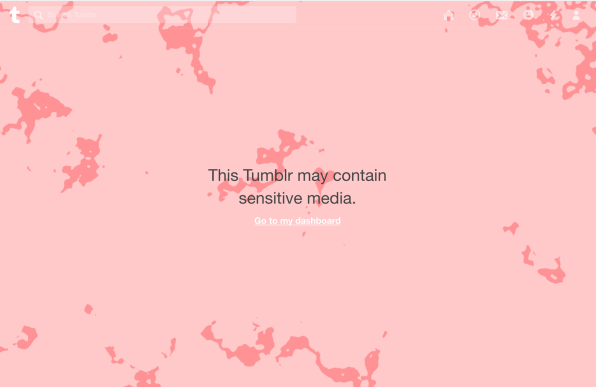Warning: This story contains links to extremely NSFW sites.
On December 3, in the wake of its removal from Apple’s App Store for child porn content, Tumblr announced a sweeping ban on NSFW content. Using its proprietary image-recognition software, the blogging site immediately began flagging pictures, videos, and GIFs of sexual acts, genitalia, and “female presenting nipples” to alert users of content that possibly infringed on the new rules. And on December 17, the ban took full effect, with any flagged posts being hidden, and a special effort placed on finding new infringing content as it went up.
Yet, nearly two months after the ban went into effect, Tumblr is still flooded with NSFW content–from female nipples to male and female genitalia to every conceivable sex act. These aren’t just old posts that the scanning software hasn’t gotten to yet. New hardcore posts are going up on the site, and in the newly reinstated iPhone app with names like Eclectic Porn, Beautiful Women, Deep N My Queen, Dark Pizza Student, and ¡¡Pero que Chicotas!!
Since announcing the NSFW ban, Tumblr and its parent company Verizon have faced harsh criticism for the performance of its image recognition algorithms. Not for banned content but false positives–overzealously flagging things like a melon, raw chicken, or bulbous rocks as forbidden content (at least into January, according to a CNN report). But it appears that the company also has an epidemic of false negatives–allowing an abundance of porn to slide through on an hourly basis.

We examined about a dozen Tumblr blogs that violated the ban–and likely could have found many more, since every click on a reposted image led to a previous source blog with yet more NSFW content. Some results were especially outrageous, like many GIFs of a women lifting up her shirt. That is, literally, as a “female presenting nipples.”
As an experiment, we tried posting NSFW content to a sample Tumblr blog we created. Reposting content from other sites, such as an explicit GIF, was not flagged. But a new upload of nude photos–one of a woman, one of a man–and a GIF of a sex act were immediately flagged (though a still-image version of the GIF remained viewable).
Tumblr hid that content from public view and sent us an email alert stating, “You’re receiving this email because we’ve detected new content on your Tumblr, [site name redacted], that has been flagged as adult under our Community Guidelines.” (An alert placed on the image in our dashboard of the blog also referred us to information on how we could appeal the decision if we felt it was in error.)
Yet many other blogs have been able to post explicit content up to today. It’s not clear why it works for some posters and not for others.
We contacted Tumblr (now owned by Verizon) for its explanation, and shared screenshots from the iOS app and links to much of the content we found online. A spokesperson issued the following statement:
“Adult content is against our policies and violates our community guidelines. When violative content is reported to us, we take action consistent with our policies, including content removal and account suspension. Tumblr is a community for creativity and free expression, but never at the expense of respect for and safety of our users.”
A representative also reiterated Tumblr’s earlier statements that the process of flagging and taking down content will take time, as it continues to train image classifying software. Human moderators also play a role in this process, Tumblr explained.
We also contacted Apple, whose banning of the Tumblr app prompted Tumblr to institute the NSFW content ban. The App Store ban was specifically predicated on the presence of child pornography–not images of adults–on Tumblr. (Apple has not yet responded to our request for comment.)
Unfortunately, Tumblr still struggles with child pornography, too. In January, for instance, police in Sarasota, Florida, arrested 23-year old Seth Smith for hosting 49 images of child pornography on his Tumblr account. According to local NBC News Channel 2, the images included rape by multiple men, bondage, and oral and anal sex.
Tumblr says it spotted the image and alerted the National Center for Missing and Exploited Children (NCMEC), which contacted the Sarasota County Sheriff’s Office. (Arrest reports are searchable on the Sherrif’s Office site.) The NCMEC and the Sheriff’s Office did not return calls for comment.
Tumblr is not alone among social networks and user-generated media sites in trying to strike a balance between free expression and what company leadership perceives as unacceptable. Just this week, for instance, Instagram and Facebook announced a ban on all images of self-harm, even scars resulting from the process. Tumblr faced a similar issue in 2012, causing concern among advocates who wanted to foster a discussion of the issue, not simply glorify it. It struck a balance in a blog post stating, “this prohibition is intended to reach only those blogs that cross the line into active promotion or glorification.”
And, as has been made abundantly clear, content-recognition software in general is limited in its ability to flag forbidden content without snagging allowed forms of expression (such as artwork) or totally innocuous images. There’s no substitute for human judgment. But there is a shortage of it, given the huge volume of inappropriate, violent, and pornographic content that is uploaded daily around the world.
This article has been updated.
Contact me confidentially at seanjcaptain@gmail.com, Twitter DM @seancaptain, or by calling me on Signal.
(143)